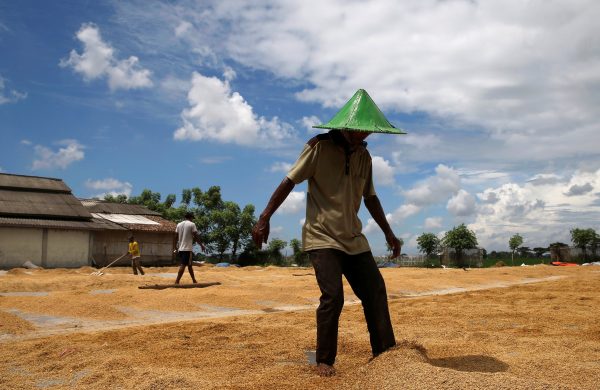At the same time, many farmers have shifted from rice to palm oil production. What factors are driving this shift and what are the implications?
Statistics Indonesia (BPS) data shows that rice production surpassed its consumption, rendering a surplus of about 2.85 million tonnes in 2018. Wholesale data has shown a 10 per cent increase in the last three years from 10,915 Indonesian rupiah (US$0.78) per kilogram in 2015 to 12,054 Indonesian rupiah (US$0.86) in 2018. This steady hike reflects a growing dependency on rice sold in the market.
Disruption in the subsistence system of rice at the household level consequently brings more problems to food security. Many paddy fields in Jambi province, for instance, are left abandoned. This is also where palm oil is gaining increasing popularity among farmers. The choice of producing palm oil is not without reason.
At the micro-level, households continuing to plant rice are encountering labour constraints. Farmers used to apply a communal rotating system, where households worked together to plant one plot before moving to another, ensuring planting was done before the rainy season’s end. This system of reciprocal and mutual assistance gradually disappeared as community obligation loosened and households increasingly worked independently.
Hiring labourers means more working capital has to be made ready in addition to seed, fertiliser and pesticide capital. This is less of a problem with palm oil, as farmers can easily borrow from palm fruit traders to be paid after harvest time.
At the macro-level, the expansion of big plantations and processing industries near villages further intensifies the labour constraints faced by household producers. Labour allocation becomes more complicated as labourers prefer working in industrial plantations rather than village or household paddy fields.
Avoiding risk, these farmers enjoy secured incomes as employees. Proximity to these processing industries brings further security to palm oil farmers. This is why it is not easy for farmers to switch to other crops, such as durian, whose markets are more uncertain, even when the President encourages them to.
A further attraction for farmers from the macro-level perspective is that palm oil prices tended to be stable, particularly relative to other estate crops like rubber and coconut. Meanwhile the price of rice is intentionally kept affordable for consumers. Consequently the incentives to be rice consumers, rather than rice producers, are greater.
At the global level, climate change has complicated matters further by taking a toll on rice production. Farmers are observing more frequent and more severe weather events, such as prolonged droughts and floods. These lead increased humidity, causing more pests and diseases. Climate change also adds difficulty in predicting the beginning of the rainy season and causes disruptions to planting patterns.
Estate crops are relatively less susceptible to climate change in contrast to food crops, palm oil harvests are less affected by prolonged droughts and floods. Palm oil farmers do not have to worry about minor seasonal shifts. Meanwhile rice production is highly sensitive, often costing total losses and failed harvests. This, added with the micro-level and macro-level issues, explains why rice production is no longer attractive, even at the subsistence level.
The total area of palm oil household-level smallholders has grown significantly, almost 27 per cent in the last three years, from 4.42 million hectares in 2014 to 5.61 million in 2017. This is more than three times greater than the increase in private estate farms. In September 2018 a Presidential Decree temporarily froze the permit of new private estates. But this moratorium will not affect the expansion of smallholders — they are not the target of the decree. Yet events at the global level would certainly have an effect on them, directly or indirectly, including the EU plan to ban biofuel palm oil imports.
Three policy issues are on the table: food security, failed harvests, and future price slumps as palm oil farmer numbers continue to rise. The government has contemplated constructing new paddy fields for extensification — instead of intensification — to strengthen food security. But unless the growing failed harvests problem is addressed, the construction of more paddy fields is ineffective.
Following the 2014 Suryana report, the optimal policy option to counter climate change-burdened harvests is to invest in resistant seeds and to educate farmers in efficient water management.
The agricultural industry also has to empower farmers by eliciting their critical thinking. While the price of palm oil has been more attractive compared to rice, what happens if they all plant it?
Farmers must protect their livelihoods by putting their eggs in different baskets.
Palmira Permata Bachtiar is a Senior Researcher for the SMERU Research Institute, Jakarta.
Asep Suryahadi is the Director of the SMERU Research Institute, Jakarta. He also sits on the Editorial Board for the Bulletin of Indonesian Economic Studies (BIES) and the Advisory Board of the Indonesia Project, The Australian National University.

